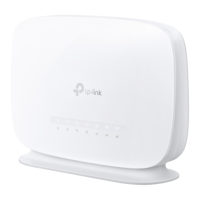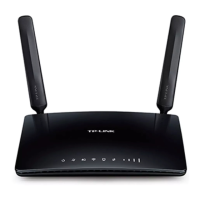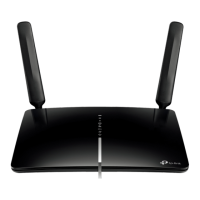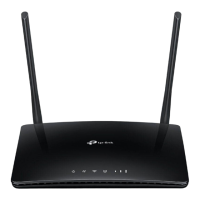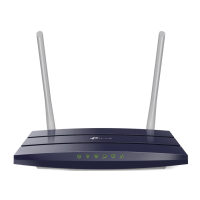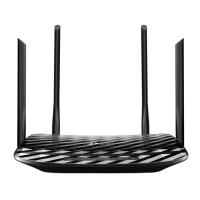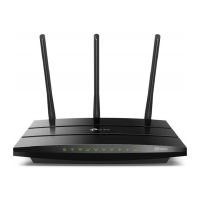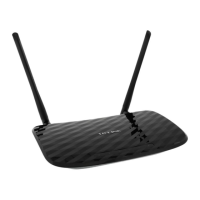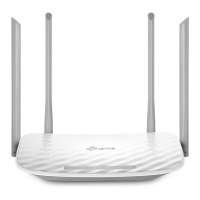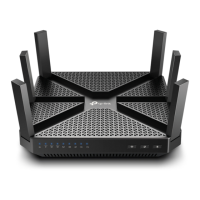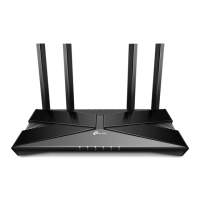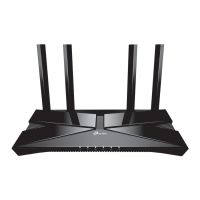Do you have a question about the TP-Link Archer MR500 and is the answer not in the manual?
Explains the conventions and symbols used throughout the user guide for clarity.
Provides links to TP-Link support, download center, community forums, and contact information.
Introduces the router's capabilities, features, and its role as a network hub.
Details the router's physical components, including front panel LEDs and rear panel ports.
Lists the necessary items and conditions required to connect and use the router.
Guides on optimal placement for signal strength and performance, considering environmental factors.
Provides step-by-step instructions for connecting the router, including antenna installation and power-up.
Explains how to access the router's web management page using a browser and initial setup.
Guides through an automated setup process for internet connection using ISP information.
Details manual configuration for internet connections if ISP settings are not auto-detected.
Explains how to configure IPv6 tunneling mechanisms like 6to4 and 6rd for IPv6 access.
Describes how to use the router's diagnostic tool to verify the internet connection status.
Explains how to create Quality of Service (QoS) rules to prioritize network traffic for specific devices or applications.
Covers SPI Firewall and DoS Protection to safeguard the network from various online threats.
Details how to block or allow specific services and applications based on defined rules.
Explains how to manage client device access to the network using Blacklist or Whitelist.
Describes binding IP to MAC addresses to prevent ARP spoofing and unauthorized access.
Explains configuring the firewall rules for the IPv6 network to control inbound traffic.
Allows blocking inappropriate websites and scheduling internet access times for specific devices.
How to access and read received SMS messages stored on the router.
Steps to compose, send, and save SMS messages.
How to view SMS messages that have been previously sent.
Accessing saved SMS messages that are not yet sent.
Configuration options for SMS functionality, including Message Center settings.
Step-by-step guide to set up a separate Wi-Fi network for guests.
Options to configure guest network security, privacy, and bandwidth settings.
Explains Application Layer Gateway (ALG) for NAT traversal support of various protocols.
How to share local network resources with the internet using Virtual Servers.
How to dynamically open ports for specific applications using Port Triggering.
How to set up a DMZ host for unrestricted internet access for specific applications.
How UPnP facilitates smooth online gaming by allowing automatic port opening.
How to update the router with the latest ISP data if not automatically detected.
Managing SIM card PIN lock, entering PIN, and using PUK for unlocking.
Monitoring and limiting router data usage against monthly allowances.
Configuring local area network IP addresses, subnet masks, and DHCP server settings.
Customizing Wi-Fi network name (SSID), password, security, and advanced parameters.
Configuring DDNS to access the router remotely using a domain name.
Defining fixed paths for network traffic to reach specific destinations.
Configuring VPN server (OpenVPN, PPTP) or client for secure remote access.
Using USSD to query service data or interact with the service provider.
Configuring the router's current time and date for accurate logging and scheduling.
Options to turn router LEDs on or off, including scheduled night mode.
Using diagnostic tools to check and troubleshoot network connection issues.
Procedures for performing online or local firmware upgrades for new features and security.
Managing router configuration files to back up current settings or restore previous ones.
Setting up automatic router restarts to enhance performance and stability.
Modifying the router's login credentials for enhanced security.
Configuring local access permissions for managing the router.
Enabling and configuring remote access to the router's management interface.
Viewing, saving, and analyzing router operational logs for troubleshooting.
Configuring CWMP (TR-069) for automatic device configuration and management.
Configuring SNMP for network monitoring, fault diagnosis, and reporting.
Viewing real-time network traffic statistics for LAN, WAN, and WLAN connections.
Steps to create a TP-Link account for cloud-based device management.
Updating the email address or password associated with your TP-Link ID.
Adding, removing, or managing other TP-Link accounts bound to the router.
Using the TP-Link Tether mobile app for convenient router management on the go.
Steps to configure TP-Link OneMesh extenders to work seamlessly with the router.
Viewing and customizing connected devices within the OneMesh network.
Procedures for resetting the router to its original factory settings.
Steps to recover lost web management or wireless network passwords.
Solutions for common problems preventing access to the router's web management page.
Information regarding Class B product interference and user precautions.
Statements of compliance with relevant European Union and United Kingdom directives.
Details on meeting electromagnetic field exposure limits for public safety.
Notes on country-specific limitations for device usage, particularly indoors.
Explains the conventions and symbols used throughout the user guide for clarity.
Provides links to TP-Link support, download center, community forums, and contact information.
Introduces the router's capabilities, features, and its role as a network hub.
Details the router's physical components, including front panel LEDs and rear panel ports.
Lists the necessary items and conditions required to connect and use the router.
Guides on optimal placement for signal strength and performance, considering environmental factors.
Provides step-by-step instructions for connecting the router, including antenna installation and power-up.
Explains how to access the router's web management page using a browser and initial setup.
Guides through an automated setup process for internet connection using ISP information.
Details manual configuration for internet connections if ISP settings are not auto-detected.
Explains how to configure IPv6 tunneling mechanisms like 6to4 and 6rd for IPv6 access.
Describes how to use the router's diagnostic tool to verify the internet connection status.
Explains how to create Quality of Service (QoS) rules to prioritize network traffic for specific devices or applications.
Covers SPI Firewall and DoS Protection to safeguard the network from various online threats.
Details how to block or allow specific services and applications based on defined rules.
Explains how to manage client device access to the network using Blacklist or Whitelist.
Describes binding IP to MAC addresses to prevent ARP spoofing and unauthorized access.
Explains configuring the firewall rules for the IPv6 network to control inbound traffic.
Allows blocking inappropriate websites and scheduling internet access times for specific devices.
How to access and read received SMS messages stored on the router.
Steps to compose, send, and save SMS messages.
How to view SMS messages that have been previously sent.
Accessing saved SMS messages that are not yet sent.
Configuration options for SMS functionality, including Message Center settings.
Step-by-step guide to set up a separate Wi-Fi network for guests.
Options to configure guest network security, privacy, and bandwidth settings.
Explains Application Layer Gateway (ALG) for NAT traversal support of various protocols.
How to share local network resources with the internet using Virtual Servers.
How to dynamically open ports for specific applications using Port Triggering.
How to set up a DMZ host for unrestricted internet access for specific applications.
How UPnP facilitates smooth online gaming by allowing automatic port opening.
How to update the router with the latest ISP data if not automatically detected.
Managing SIM card PIN lock, entering PIN, and using PUK for unlocking.
Monitoring and limiting router data usage against monthly allowances.
Configuring local area network IP addresses, subnet masks, and DHCP server settings.
Customizing Wi-Fi network name (SSID), password, security, and advanced parameters.
Configuring DDNS to access the router remotely using a domain name.
Defining fixed paths for network traffic to reach specific destinations.
Configuring VPN server (OpenVPN, PPTP) or client for secure remote access.
Using USSD to query service data or interact with the service provider.
Configuring the router's current time and date for accurate logging and scheduling.
Options to turn router LEDs on or off, including scheduled night mode.
Using diagnostic tools to check and troubleshoot network connection issues.
Procedures for performing online or local firmware upgrades for new features and security.
Managing router configuration files to back up current settings or restore previous ones.
Setting up automatic router restarts to enhance performance and stability.
Modifying the router's login credentials for enhanced security.
Configuring local access permissions for managing the router.
Enabling and configuring remote access to the router's management interface.
Viewing, saving, and analyzing router operational logs for troubleshooting.
Configuring CWMP (TR-069) for automatic device configuration and management.
Configuring SNMP for network monitoring, fault diagnosis, and reporting.
Viewing real-time network traffic statistics for LAN, WAN, and WLAN connections.
Steps to create a TP-Link account for cloud-based device management.
Updating the email address or password associated with your TP-Link ID.
Adding, removing, or managing other TP-Link accounts bound to the router.
Using the TP-Link Tether mobile app for convenient router management on the go.
Steps to configure TP-Link OneMesh extenders to work seamlessly with the router.
Viewing and customizing connected devices within the OneMesh network.
Procedures for resetting the router to its original factory settings.
Steps to recover lost web management or wireless network passwords.
Solutions for common problems preventing access to the router's web management page.
Information regarding Class B product interference and user precautions.
Statements of compliance with relevant European Union and United Kingdom directives.
Details on meeting electromagnetic field exposure limits for public safety.
Notes on country-specific limitations for device usage, particularly indoors.
| DSL WAN | No |
|---|---|
| Ethernet WAN | Yes |
| WAN connection type | RJ-45 |
| Wi-Fi band | Dual-band (2.4 GHz / 5 GHz) |
| Wi-Fi standards | 802.11a, 802.11b, 802.11g, Wi-Fi 4 (802.11n), Wi-Fi 5 (802.11ac) |
| Top Wi-Fi standard | Wi-Fi 5 (802.11ac) |
| WLAN data transfer rate (max) | 867 Mbit/s |
| Antennas quantity | 2 |
| VPN server | PPTP VPN, OpenVPN |
| Cable standard | Cat6 |
| Networking standards | IEEE 802.11a, IEEE 802.11ac, IEEE 802.11b, IEEE 802.11g, IEEE 802.11n |
| Ethernet LAN data rates | 10, 100, 1000 Mbit/s |
| Ethernet LAN interface type | Gigabit Ethernet |
| Number of guest networks (2.4 GHz) | 1 |
| Supported network protocols | IPv4, IPv6 |
| 4G standard | LTE-FDD |
| 3G standards | DC-HSPA+, HSPA, UMTS |
| SIM card type | NanoSIM |
| GSM bands supported | 850, 900, 2100 MHz |
| Mobile network generation | 4G |
| Security algorithms | 64-bit WEP, 128-bit WEP, WPA, WPA-Enterprise, WPA2, WPA2-Enterprise |
| Certification | CE, RoHS |
| Ethernet LAN (RJ-45) ports | 4 |
| Product type | Tabletop router |
| Product color | Black |
| Power source type | DC |
| Storage temperature (T-T) | 5 - 90 °C |
| Operating temperature (T-T) | 0 - 40 °C |
| Operating relative humidity (H-H) | 10 - 90 % |
| Windows operating systems supported | Windows 10, Windows 2000, Windows 7, Windows 8, Windows 8.1, Windows 98SE, Windows NT, Windows Vista, Windows XP |
| Sustainability certificates | RoHS |
| Cables included | LAN (RJ-45) |
| Package type | Box |
| Package depth | 223 mm |
| Package width | 307 mm |
| Package height | 70 mm |
| Package weight | 783 g |
| Depth | 141 mm |
|---|---|
| Width | 202 mm |
| Height | 33.6 mm |
